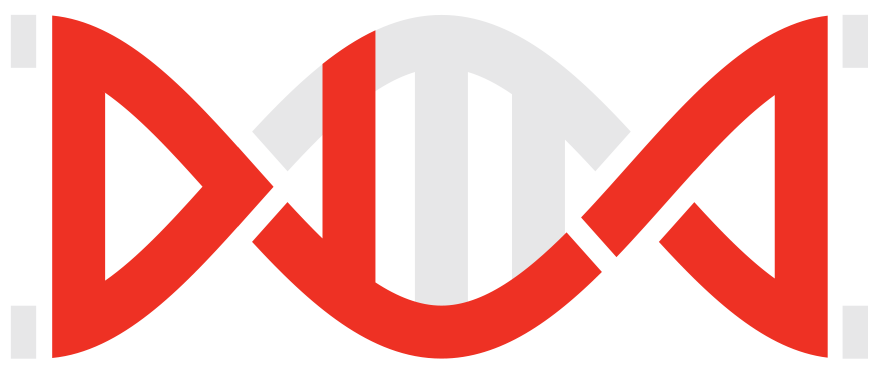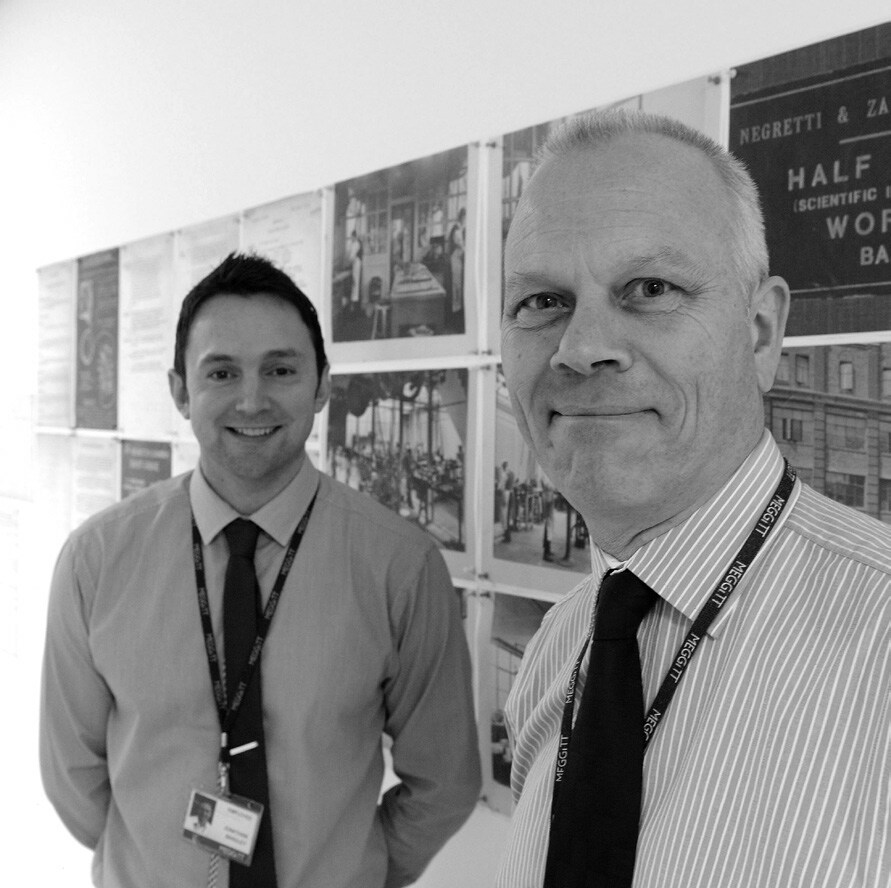Evolving the DNA of DLA
Steve Favell (Manufacturing Manager) and Jon Bradley (Continuous Improvement Facilitator) have helped lead implementation of Meggitt Production System at Meggitt Avionics. The experience has been a co-operative one for pilot sites and Favell and Bradley are proud to be so closely involved in helping to evolve the DNA of Daily Layered Accountability. Here they share their thoughts on the many changes they’ve experienced.

Q: How has MPS changed your own roles?
Steve: Twelve months ago I was what you might call a traditional manufacturing manager, focused on turning the handle. Now I oversee continuous improvement and implementation of the MPS system as well as security, safety and site services. But if I was still a manufacturing manager my role would be very different too. It used to be about dealing with what was right in front of you. Now you need a much broader and longer view of production.
Jon: The way my role has changed tells you a lot about how MPS has changed Meggitt Avionics. If there was a problem, a quality issue say, I’d get the right people together to investigate it, identify the problem, find a solution, follow it through and embed the improvement. Now the day-to-day problem-solving behaviour and continuous improvement mind-set have been embedded in the teams themselves. That’s a big difference.
Q. Both of you share Mark Crompton’s view that MPS is as good as any production system gets. At what point did you realise what you had on your hands?
Steve: When we got the Daily Layered Accountability structure in place, with the three levels aligned. We saw instant results as soon as we had Focus Factory—the daily site-level leadership review—up and running. Arrears came down and on-time delivery (OTD) improved. Everyone could see real change and straight away we had them all pulling in the same direction.
Q. How do you explain the speed of the change?
Steve: DLA pulls so many levers simultaneously. The engagement of the shopfloor, support from senior management, coaching. And the discipline of accountability is very important. I think of it as daily layered accountability with a capital A.
Jon: You can see it at our RAIL [rolling action item list] meetings. We used to spend an hour-and-a-half going through a hundred-odd issues. Now we deal only with the top issues—the Vital Few—all the time pushing for closure. You see that discipline of DLA transforming everyone’s behaviour.
Q: Even at the very top?
Steve: Especially at the very top. At Focus Factory, the site leadership meeting, everyone will be waiting for it to start on time, just like the Level One and Two DLAs on the shopfloor. It’s very unusual for directors to arrive late but if they do they will be rushing and a bit embarrassed. And it’s rare for people not to be able to answer the questions too. People do their homework now. It’s a pride thing. No-one wants to be seen wasting colleagues’ time or letting someone else down.
Q: If you took DLA away, do you think the rest of MPS would still work?
Steve: I don’t see how it could. Everything hangs off that shared awareness and discipline created by daily communication. And it’s also the mechanism that breaks down the old functional divisions and turns us into a single team with shared objectives.
Jon: We were already doing some MPS-type things. Our Integrated Management Team (IMT) meeting ran for 10 years. It was good and people did their best with it but something was missing. It needed to be plonked in the middle of a structure that supported it from above and fed it with information from the coalface. It’s integrated within our Level Two DLA meeting now.
It’s very unusual for directors to arrive late but if they do they will be rushing and a bit embarrassed
Q: We’ve heard about how DLA is a ‘silo buster’. Can you explain what that means for Meggitt Avionics?
Steve: Rather than trying to make the production process suit all the different functions, DLA forces us all to concentrate on what the functions need to do to support production. The old conflict between diversions, production costs and OTD is a good example. [Diversions are work charged to overhead.] If you said to people, “diversions are bad”, they’d book all their time to work-in-progress and suddenly your unit costs were going up. But then when someone said, “We need to get work-in-progress under control to improve our margins”, suddenly diversions and overheads would be rising again. So what you had was a knee-jerk reaction, giving the desired effect, but without actually solving the underlying problem, just shifting it somewhere else. We were squeezing the balloon in one place only to have it bulge out somewhere else. That shouldn’t happen now because everyone comes together every day to look at the same picture. And if it does happen? The story comes up from the shopfloor and Focus Factory is straight on to it.
Jon: The ‘rework’ story is much the same. Without DLA senior management would see rework rising but have no idea what was causing it. And on the shopfloor we were prioritising OTD and fire-fighting instead of tackling root causes.
If you are just starting out with your own DLA board, my big tip would be: don’t spend too much time in the meeting room. Get the boards up and running quickly and then refine them. That will also get more coaching coming from within the teams themselves

Above: Back: Jon Bradley. Front: Steve Favell. With MPS, the more we do, the more we realise what we can do.
We were squeezing the balloon in one place only to have it bulge out somewhere else. That shouldn’t happen now because everyone comes together every day to look at the same picture. And if it does happen? The story comes up from the shopfloor and Focus Factory is straight on to it
Q: So how is it different now?
Steve: The Living Pareto charts on the DLA boards leave nowhere for recurring problems to hide. Something fundamental that can’t be solved at the cell level gets to Focus Factory very quickly and directors are soon saying, “We’re doing what? Stop! We are going to spend a day to fix this properly.” The culture has changed. No-one who touches the process is prepared to accept the same problem appearing over and over again.
Jon: And in some cases the process change or component redesign that comes out of the kaizen won’t be the end of it either. The existing RFC [request for change] might prioritise use of existing stock. If you don’t pick that up as well it could take a year for a component improvement to enter production. Without the constant reporting and daily reviews of DLA that sort of thing could also stay hidden or ignored for ages, saving a few pounds of stock but costing thousands in rework.
Q: Have people taken easily to those DLA boards or is this an area of MPS implementation that needs lots of support?
Steve: We do a lot of coaching work around DLA board design and use. It is an absolutely key part of encouraging the behaviours that make DLA work as a process. Everyone needs to be coached and encouraged to think about how they can go on to embed coaching others into their day job. DLA meetings are great opportunities for coaching because you see people in action every morning and you can respond immediately to something. If you are just starting out with your own meetings, my big tip would be: don’t spend too much time in the meeting room. Get the boards up and running quickly and then refine them. That will also get more coaching coming from within the teams themselves.
Jon: We attend a lot of DLA meetings to observe roles, language, behaviour, communications style. We look at technical aspects too. KPI selection and alignment, data presentation and so on. The board should meet the team’s particular needs but standards matter too. They need to be understandable to everyone at a glance.
Steve: We’ve used the training materials to pull together some reporting sheets covering the key issues. They were meant to record what we were doing, not to score performance. But the cells themselves soon wanted to use them as well.
Q: Do you think there are any functions that wouldn’t benefit from using MPS?
Steve: I can’t think of any. We’ve had some great success beyond the shopfloor. For example, we used to get any number of units that didn’t ship purely because they were on some kind of ‘hold’ controlled by Commercial—a credit issue, contract problem or something. Now, a visual management system called the Shipping Dashboard shows exactly what the commercial team needs to do to avoid delivery delays.
Q: Given your early successes, do you think there is any sense in which Meggitt Avionics has reached a plateau with MPS?
Steve: Not at all. We’ve started this, it’s rolling—but if you ask anybody they’ll tell you there’s lots more we can do. With MPS the more we do, the more we realise what we can do. And that’s how it should be. To get the best out of MPS you can’t be the kind of person who sits back and says, “Yes, this is good enough.” You’ve lost any impetus to improve then. Who’d want that? ■
